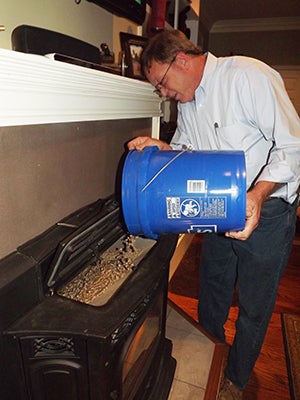Wood pellet stove keeps utilities director warm
Published 11:13 am Saturday, January 4, 2014
Who’s staying warm this winter and saving money? Julien Johnson, for one. The director of public utilities for Southampton County, who lives in the Holland Borough of Suffolk, discovered a few years ago just how efficient a pellet stove can be for his family.

Julien Johnson, director of utilities for Southampton County, pours some of the first wood pellets made by Enviva into the stove at his home in the Holland Borough of Suffolk. The capsules were given to Johnson as a one-time only courtesy. Photo by Stephen H. Cowles
The stove burns capsules of wood, just like the kind that Enviva is making. In fact, Johnson got five gallons worth of the first pellets that company was manufacturing this past fall.
He said he offered to pay for them, but was told those were on the house for novelty’s sake. By the way, the company makes the pellets for export, so don’t bother asking for a sample or even purchase. Instead, you can do as Johnson has done and buy large bags of the capsules at stores that sell them. For his purpose, he has three pallets worth to get him through the cold months ahead.
Then there’s the stove itself, designed to look like a fireplace.
“It’s the coolest thing that ever came down the pike,” Johnson said. “This sucker will pay for itself. Mine cost almost $4,000.”
He said that some stoves can be priced lower, around $800 to $1,000. By the way, he added, you don’t need a chimney to install one, just a vent through a wall to the outside.
Johnson said that before the conversion he had just heat pumps, although the pellet stove also required a pump. Naturally, the heat rises to warm the rooms above on the second floor as well as the rest of the house.
Previous to the conversion, Johnson said, he was paying $700 to $800 monthly in heating bills. Now he’s down to about $200 to $250.
“It’s so efficient. A lot better than I expected,” he said. “We’re saving so much in energy.”





